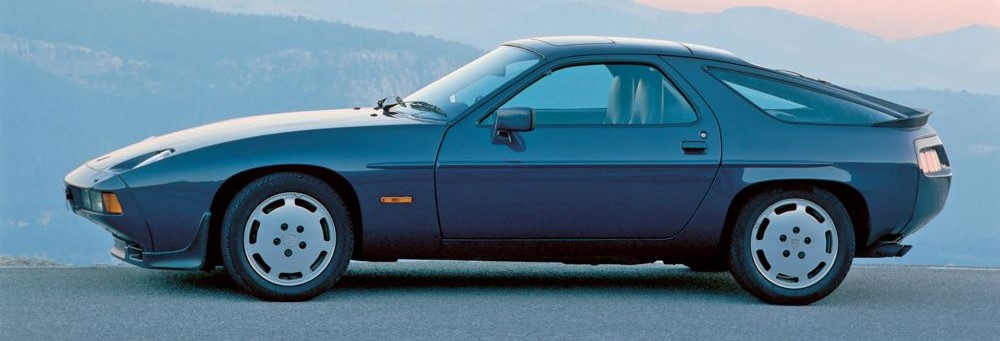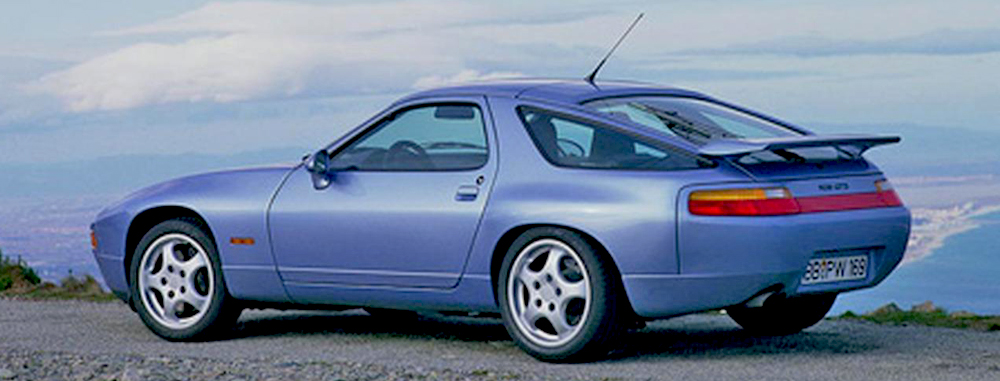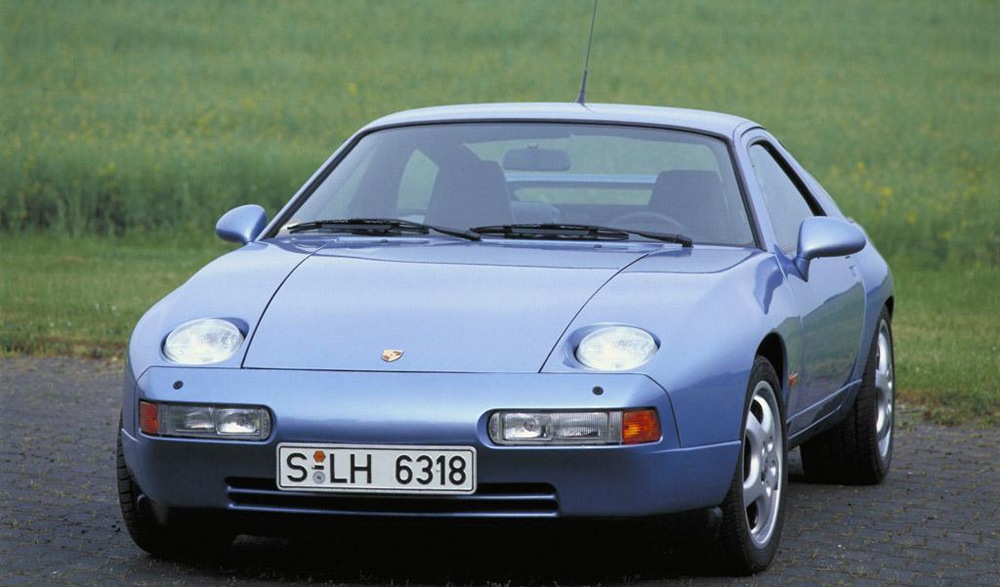
When designing the 928, which was mass-produced from model year 1978, the focus was on lightweight construction. For this reason, the doors, front wings and bonnet were all made of aluminium instead of sheet steel. Integrated into the bodyshell shape behind the plastic bumpers, there were also aluminium profiles that could withstand an impact at up to 8 km/h (5 mph) without sustaining damage.
The 928 had round headlights, which were integrated into the wings and could be raised electrically. The rounded fastback was dominated by the large window on the rear lid.
The 928 models were powered by a water-cooled V8 engine with a 90° cylinder arrangement. The engine’s displacement was initially 4.5 litres and was later increased to 5.4 litres. Power was transmitted via a transaxle construction.
To improve aerodynamics, the 928 S models (mode year 1979) were given front and rear spoilers.
The rear axle on the 928 was a complete novelty. What was special about this double-wishbone suspension – also known as the Weissach axle – was its toe-in stabilizing effect. This worked more or less like a passive rear wheel steering and made a significant contribution to the active safety of the Gran Turismo.
Years of production: 1977–1995
Porsche 928 S
Year of production: 1983
Power unit: V8
Capacity: 4664 cc
Output: 300 bhp (221 kW)
Top speed: 250 km/h (155 mph)
The 928 was originally intended as the successor to the 911, but quickly emancipated into a unique model in its own right. In 1978, just one year after being launched into the market, the 928 became the first sports car in history to be elected as the “Car of the Year”. In technical terms the concept differed fundamentally from the 911 through its transaxle transmission, the water-cooled V8 light-alloy power unit, and the aluminum suspension.
The 928 GT (spring 1989 to MY 1991)
The 928 GT had a sportier design than the 928 S4. Thanks to various modifications, its engine generated power of up to 330 PS. As standard, the GT was delivered without side protection strips and with wheels in a unique design.

Porsche 928 GTS
The Porsche 928 GTS is the final and most refined version of the 928 series, produced from 1992 to 1995. It represents the pinnacle of the 928 line, with significant upgrades in performance, design, and features compared to earlier models.
The GTS is powered by a 5.4-liter V8 engine producing 345 horsepower and 369 lb-ft of torque. It features advanced engine management systems and enhanced cooling to ensure reliability and performance. The GTS can accelerate from 0 to 60 mph in approximately 5.4 seconds, with a top speed of around 171 mph.
The GTS has a more aggressive and refined design, with wider rear fenders and a smoother, more aerodynamic shape. It features distinctive round tail lights and a rear spoiler integrated into the hatch, contributing to its sporty appearance. The standard 17-inch “Cup” wheels add to the car’s dynamic stance and handling capabilities.
The interior of the GTS is luxurious, with high-quality materials and advanced features for its time. The standard equipment includes leather seats, automatic climate control, and an upgraded sound system. Also offers power-adjustable seats and a comprehensive array of electronic adjustments to enhance driver and passenger comfort.
The GTS benefits from an advanced suspension system with adaptive dampers, providing a balance between comfort and sporty handling. It features a limited-slip differential and an upgraded braking system, ensuring excellent stopping power and stability.
The GTS was available with both a 5-speed manual and a 4-speed automatic transmission, catering to different driving preferences.
The GTS was positioned as a high-end grand tourer, appealing to buyers looking for a combination of performance and comfort in a stylish package. It is highly regarded for its blend of luxury, performance, and innovative technology.
Porsche 928 GTS Specifications (1992-1995)
928 GTS (MY 1992–95)
The last evolutionary stage of the 928 series, the 928 GTS had flared rear wings, a Red light strip on the rear, a rear spoiler painted in the vehicle colour, Cup-design exterior mirrors and 17-inch Cup rims as standard. The 5.4-litre engine produced 350 PS.
Engine/Performance and Transmission
- Engine Type: 5.4-liter V8
- Horsepower: 345 hp (350 PS)
- Torque: 369 lb-ft (500 Nm)
- Compression Ratio: 10.4:1
- Fuel Injection: Bosch LH-Jetronic
- Top Speed: Approximately 171 mph (275 km/h)
- 0-60 mph: Around 5.4 seconds
- Manual Transmission: 5-speed manual
- Automatic Transmission: 4-speed automatic (with Porsche’s four-speed automatic transmission)
- Drive Type: Rear-wheel drive
Dimensions and Weight
- Length: 4,520 mm (178 in)
- Width: 1,890 mm (74.4 in)
- Height: 1,280 mm (50.4 in)
- Wheelbase: 2,500 mm (98.4 in)
- Curb Weight: Approximately 1,620 kg (3,571 lbs)
Chassis and Suspension
- Front Suspension: Double wishbone
- Rear Suspension: Multi-link
- Brakes: Ventilated discs (front and rear)
- Tires: Front: 225/45 ZR17, Rear: 255/40 ZR17
- Wheels: 17-inch “Cup” design wheels
Interior and Features
- Seating: 2+2 seating configuration
- Interior Materials: High-quality leather upholstery
- Climate Control: Automatic climate control
- Audio System: Upgraded sound system (typically with options for high-end audio equipment)
- Power Features: Power-adjustable seats, power windows, and mirrors
Exterior Features
- Body Style: 2-door coupé
- Aerodynamics: Integrated rear spoiler, smooth aerodynamic lines
- Lighting: Round tail lights, pop-up headlights
Fuel Economy
- Fuel Tank Capacity: 86 liters (22.7 gallons)
- Fuel Economy: Varies by driving conditions, typically around 14-17 mpg (combined city and highway)
Additional Features
- Limited-Slip Differential: Standard on GTS models
- Adaptive Dampers: Adjustable suspension settings for enhanced handling and comfort
- Braking System: Upgraded high-performance brakes for better stopping power



You must be logged in to post a comment.